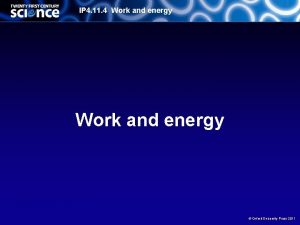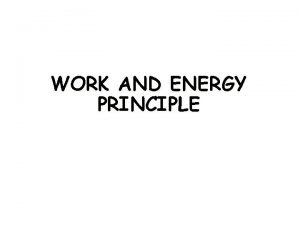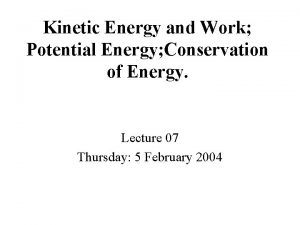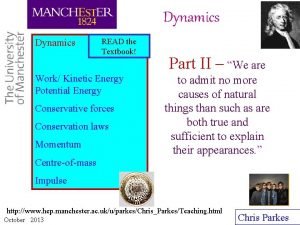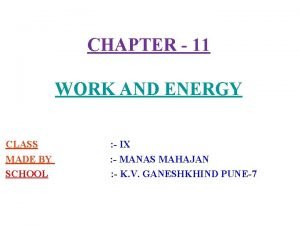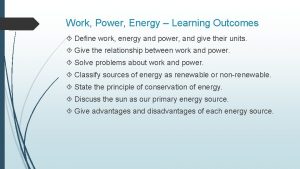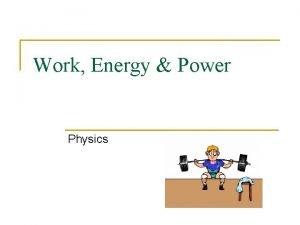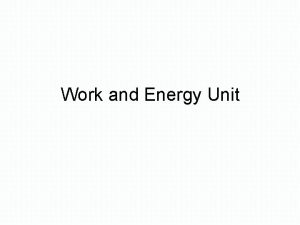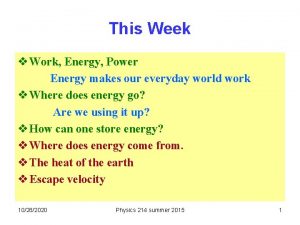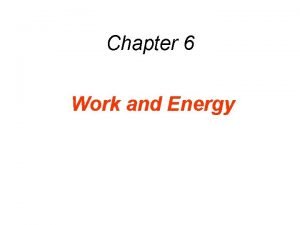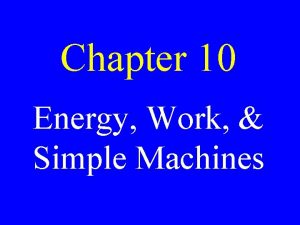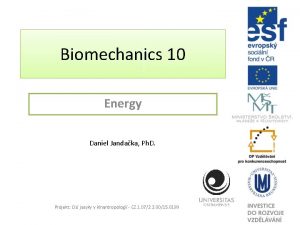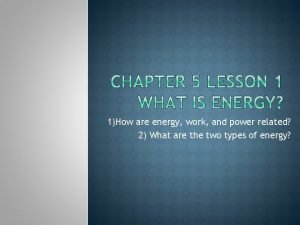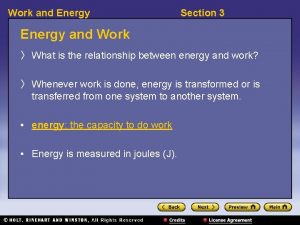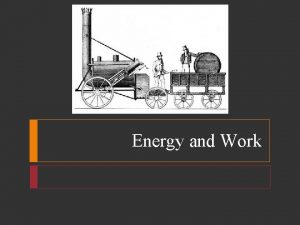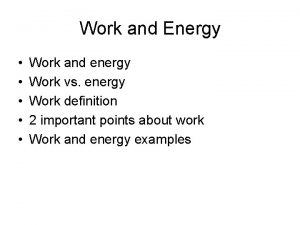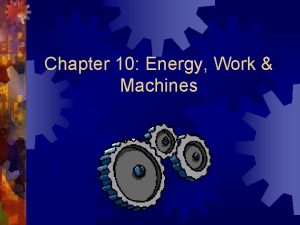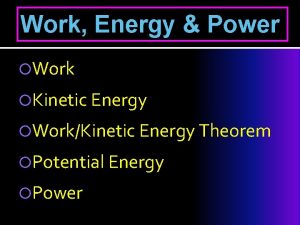IP 4 11 4 Work and energy Oxford































- Slides: 31

IP 4. 11. 4 Work and energy © Oxford University Press 2011

© Class Leading Ltd. 2013. Permission granted for non-commercial educational use provided that this copyright notice is included. 07. 10. 20 20 Using IP 4. 11. 4 Work and energy graphs to summarise motion D 1. Distances measured in one direction are ____, and in the other are _______ 2. The _______ of an object is its ______ and the ____ of motion. 3. The velocity of an object moving in a straight line is ____ if it is moving in one direction and ____ if it is moving in the opposite direction. C 4. Sketch a velocity-time graph for an object that is: a) stationary b) moving in a straight line with constant speed c) moving in a straight line with steadily increasing v 5. Sketch a distance-time graph for an object that is: a) stationary b) moving at constant speed d A/B c speed a b negative t direction positive b velocity a c c) moving with increasing speed t distance /m 200 6. Using the graph to the right A a) which is moving faster, A or B? A – steeper slope / gradient 100 B b) Calculate the speed of B Speed = gradient = (100 -0) = 100 = 5 m/s (20 -0) 20 10 20 negative positive © Oxford University Press 2011 time/s

IP 4. 11. 4 Work and energy Doing work: When you push or pull something and make it move, you do work. © Oxford University Press 2011

IP 4. 11. 4 Work and energy Energy and work • • Whenever an object moves energy is used This also means that work has been done E. g you open a door You have used force to open the door You have used up energy to open the door Therefore you have done work The energy has been transferred to opening the door © Oxford University Press 2011

IP 4. 11. 4 Work and energy • When an object is moved by a force, we say work is done on the object by the force • The work done on the object is equal to the energy transferred to the object • E. g. the energy you use to open the door is transferred to the door (door moves) • If the energy you used up to open the door was 20 J then the work done was 20 J • Where does the energy come from? • When you do work against friction, most of the energy gets lost as heat and sometimes as sound © Oxford University Press 2011

IP 4. 11. 4 Work and energy How much work? Imagine pushing a car along a road. • You must apply a force. . . • . . . and you push the car a certain distance. work done (in joules) = force (in newtons) distance (in metres) © Oxford University Press 2011

IP 4. 11. 4 Work and energy Work done, GPE and KE LQ: Can I calculate the energy used in different situations? © Oxford University Press 2011

IP 4. 11. 4 Work and energy An example I push my car 30 m. I push with a force of 400 N. work done = force distance = 400 N 30 m = 12 000 J © Oxford University Press 2011

IP 4. 11. 4 Work and energy Lifting something • If you lift something up, you must exert enough force to balance the force of gravity. • The upward force is equal to the weight of the object. © Oxford University Press 2011

IP 4. 11. 4 Work and energy Lifting something If you lift something through a certain distance work done = force distance where force = weight of the object lifted © Oxford University Press 2011

IP 4. 11. 4 Work and energy An example A woman lifts up her baby from the floor. The baby weighs 100 N. The woman lifts the baby up by 2 m. work done = force distance = weight distance = 100 N 2 m = 200 J © Oxford University Press 2011

IP 4. 11. 4 Work and energy Work done = energy transferred When someone does work, energy is transferred: • from the person who exerts the force • to other places. amount of work done = amount of energy transferred © Oxford University Press 2011

IP 4. 11. 4 Work and energy Let’s look first at lifting distance lifted When you lift something up, you do work done = force distance = weight distance lifted The gravitational potential energy of the object you lift has increased: change in gravitational potential energy = weight height gain © Oxford University Press 2011

IP 4. 11. 4 Work and energy Different paths? What if you lift something, but not straight up? work done = force distance moved in the direction of the force change in gravitational potential energy = weight vertical height gain © Oxford University Press 2011

IP 4. 11. 4 Work and energy 1. Hannah pushes a book 5 m along the table with a force of 5 N. She gets tired and decides to call it a day. How much work did she do? 2. Courtney lifts a laptop 2 m into the air with a force of 10 N. How much work does she do? What type of energy did the laptop gain? 3. Tom does 200 J of work by pushing a wheelbarrow with a force of 50 N. How far did he push it? What type of energy did the wheelbarrow gain? 4. Dan cuddles his cat and lifts it 1. 5 m in the air. If he did 75 J of work how much force did he use? 5. Simon drives his car 1000 m. If the engine was producing a driving force of 2000 N how much work did the car do? 25 J 20 J, GPE 4 m, KE 50 N 2 MJ © Oxford University Press 2011

IP 4. 11. 4 questions… Work and energy Some example How much gravitational potential energy have the following objects gained? : 1. A brick that weighs 10 N lifted to the top of a house (10 m), 100 J 2. A 1, 000 kg car lifted by a ramp up to a height of 2 m, 20 KJ 3. A 70 kg person lifted up 50 cm by a friend. 350 J How much GPE have the following objects lost? : 1. A 2 N football dropping out of the air after being kicked up 30 m, 60 J 2. A 0. 5 N egg falling 10 m out of a bird nest, 5 J 3. A 1, 000 kg car falling off its 200 cm ramp. 20 KJ © Oxford University Press 2011

IP 4. 11. 4 Work and energy © Oxford University Press 2011

IP 4. 11. 4 Work and energy © Oxford University Press 2011

IP 4. 11. 4 Work and energy © Oxford University Press 2011

IP 4. 11. 4 Work and energy © Oxford University Press 2011

IP 4. 11. 4 Work and energy Work done = energy transferred What happens if you push something horizontally? • Imagine pushing a cart with very -oiled wheels (no friction). well • The speed of the cart will increase while the force acts. work done = change in kinetic energy of the cart © Oxford University Press 2011

IP 4. 11. 4 Work and energy Calculating kinetic energy The kinetic energy of a moving object depends on: • its mass (how big it is) • its speed (how fast it is moving). The equation for calculating the kinetic energy of a moving object is: kinetic energy = ½ mass (speed)2 © Oxford University Press 2011

IP 4. 11. 4 Work and energy What if friction cannot be ignored? Think about pushing a car. As you push it, you transfer energy from your body to: • the car – increasing its kinetic energy • parts of the car (and the surroundings) – which heat up because of friction. the amount of work you do = the amount of energy transferred © Oxford University Press 2011

IP 4. 11. 4 Work and energy Now let’s look at an example that brings several of these ideas together. . . pushing a car up a slope. © Oxford University Press 2011

IP 4. 11. 4 Work and energy Pushing a car uphill • If you push your car uphill, you do work: work done = force distance • You increase the gravitational potential energy of your car: change in gravitational potential energy = weight vertical height gain • Are these the same? If not, why not? © Oxford University Press 2011

IP 4. 11. 4 Work and energy The calculation work done in pushing = force distance = 450 N 30 m = 13 500 J gain in gravitational potential energy = weight vertical height gain = 900 N 1 m = 9000 J © Oxford University Press 2011

IP 4. 11. 4 Work and energy So why the difference? • Some of the energy is transferred to the surroundings – heating them up. • Only part of it goes to increasing the gravitational potential energy of the car. • If no energy is lost as heat you can assume that kinetic energy = gravitational potential energy (for falling objects only) © Oxford University Press 2011

A diver who has a mass of 50 kg dives off a diving board 3. 0 metres above the water level. What is her kinetic energy when she reaches the w IP 4. 11. 4 Work and energy • A diver who has a mass of 50 kg dives off a diving board 3. 0 metres above the water level. What is her kinetic energy when she reaches the water? © Oxford University Press 2011

IP 4. 11. 4 Work and energy • Kinetic energy gained = gravitational potential energy lost • Kinetic energy gained = weight × height • You must calculate her weight to use in this equation • Weight = mass × gravitational field strength • Weight = 50 kg × 10 N / kg • Weight = 500 N • Kinetic energy gained = weight × height • Kinetic energy gained = 500 N × 3 m • Kinetic energy gained = 1500 J © Oxford University Press 2011

IP 4. 11. 4 Work and energy • How fast is the diver moving when she reaches the water? • Ke = 0. 5 mv 2 © Oxford University Press 2011

IP 4. 11. 4 Work and energy • Put her kinetic energy (the 1500 J you have calculated) into the kinetic energy equation together with her mass • Kinetic energy = 1/2 × mass × speed 2 • 1500 J = ½ × 50 × speed 2 = 25 × speed 2 • So speed 2 = 1500/25 = 60 (This is not the answer yet! It is speed 2!) • So her speed = square root of 60 = 7. 7 m/s © Oxford University Press 2011
 Section 4 review physical science
Section 4 review physical science Work energy theorem
Work energy theorem Work and energy section 2 describing energy
Work and energy section 2 describing energy Energy energy transfer and general energy analysis
Energy energy transfer and general energy analysis Energy energy transfer and general energy analysis
Energy energy transfer and general energy analysis Energy calculations oxford
Energy calculations oxford Smart work and hard work
Smart work and hard work Principle of work and kinetic energy
Principle of work and kinetic energy Kinetic energy proof
Kinetic energy proof Chart on work and energy
Chart on work and energy Formula for work done by friction
Formula for work done by friction Learning objectives of work and energy
Learning objectives of work and energy Chapter 11 work and energy
Chapter 11 work and energy Differentiate between simple machine and compound machine
Differentiate between simple machine and compound machine Sound energy definition
Sound energy definition Work-energy theorem formula
Work-energy theorem formula Work, power and energy activities
Work, power and energy activities Energy transformation in a lawn mower
Energy transformation in a lawn mower Work and energy powerpoint
Work and energy powerpoint Work and energy
Work and energy Unit of resistivity
Unit of resistivity Energy enables you to work and play
Energy enables you to work and play Work and energy
Work and energy Definition of work done
Definition of work done Chapter 10 energy, work and simple machines answer key
Chapter 10 energy, work and simple machines answer key Energy work and simple machines chapter 10 answers
Energy work and simple machines chapter 10 answers Jandaka
Jandaka How are work and power related
How are work and power related Work and energy section 2
Work and energy section 2 Work power energy and machines
Work power energy and machines Chapter 6 work and energy powerpoint
Chapter 6 work and energy powerpoint F d cos theta
F d cos theta





